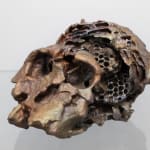Nicolás Lamas
Collective memory, 2023
Bronze, metal and glass
77 x 50 x 30 cm
30 1/4 x 19 3/4 x 11 3/4 inches
30 1/4 x 19 3/4 x 11 3/4 inches
Copyright The Artist
Photo: Studio Nicolás Lamas
Further images
Die Skulpturen von Nicolas Lamas, die sich aus organischen Elementen, präzise gefertigten Strukturen und gebrauchten Alltagsgegenständen zusammensetzen wirken wie hybride Artefakte, die verschiedene Zeitlinien verbinden. Sie spiegeln das Interesse des...
Die Skulpturen von Nicolas Lamas, die sich aus organischen Elementen, präzise gefertigten Strukturen und gebrauchten Alltagsgegenständen zusammensetzen wirken wie hybride Artefakte, die verschiedene Zeitlinien verbinden. Sie spiegeln das Interesse des Künstlers an Archäologie und der Entstehung technischer Errungenschaften über Jahrtausende hinweg. „Technologie entwickelt sich weiter und blickt in die Zukunft, während die Archäologie eine Disziplin ist, die per Definition ständig Daten aus der Vergangenheit sammelt, und zwar anhand der materiellen Spuren, die unsere Vorfahren hinterlassen haben. Manchmal vergessen wir jedoch, dass sich sowohl die Vergangenheit als auch die Zukunft ständig weiterentwickeln.“ Die Assemblagen eröffnen so Dialoge über Vergänglichkeit, Hybridität und die Trennung von Kultur und Natur. Die verschiedenen Materialitäten scheinen zunächst konträr zueinander zu stehen, weisen aber bei genauerer Auseinandersetzung formale und inhaltliche Gemeinsamkeiten auf. Die einzelnen Elemente verfügen für den Künstler über eine eigene Kraft, durch die eine Unterscheidung von menschgemacht und organisch gewachsen hinfällig wird. Durch diese Begegnungen versucht Lamas, die Funktion und den Wert der Dinge zu relativieren und andere Wege zu öffnen, um ihre Existenz neu zu definieren.
In „Collective memory“ (2023) wird der fossile Schädel von „Kenyanthropus platyops“, einer vor etwa 3,5 Millionen Jahren ausgestorbenen Hominidenart mit einem Wespennest kombiniert. Der Schädel, Zeugnis der menschlichen Evolutionsgeschichte, steht im Dialog mit dem Wespennest – einem Relikt der sozialen Intelligenz und evolutionären Anpassung eines hochentwickelten Insektenkollektivs. Diese Gegenüberstellung verdeutlicht den Kontrast zwischen menschlicher Evolution und der fortwährenden Schwarmintelligenz sozialer Insekten.
Nicolas Lamas' sculptures, composed of organic elements, precisely produced structures, and used everyday objects, resemble hybrid artifacts that connect different timelines. They reflect the artist’s interest in archaeology and the development of technological achievements over millennia. “Technology continues to advance and looks toward the future, while archaeology is a discipline that, by definition, constantly gathers data from the past through the material traces left by our ancestors. However, we sometimes forget that both the past and the future are in constant evolution.” The assemblages thus open dialogues about transience, hybridity, and the separation of culture and nature. At first glance, the different materials appear to be in opposition to each other, but upon closer examination, they reveal formal and thematic similarities. For the artist, the individual elements possess their own power, making the distinction between man-made and organically grown irrelevant. Through these encounters, Lamas seeks to relativize the function and value of objects, opening up new ways to redefine their existence.
In "Collective Memory" (2023), the fossil skull of "Kenyanthropus platyops," a hominid species that went extinct around 3.5 million years ago, is combined with a wasp nest. The skull, a testament to human evolutionary history, enters into a dialogue with the wasp nest—an artifact of the social intelligence and evolutionary adaptation of a highly developed insect collective. This juxtaposition highlights the contrast between human evolution and the ongoing swarm intelligence of social insects.
In „Collective memory“ (2023) wird der fossile Schädel von „Kenyanthropus platyops“, einer vor etwa 3,5 Millionen Jahren ausgestorbenen Hominidenart mit einem Wespennest kombiniert. Der Schädel, Zeugnis der menschlichen Evolutionsgeschichte, steht im Dialog mit dem Wespennest – einem Relikt der sozialen Intelligenz und evolutionären Anpassung eines hochentwickelten Insektenkollektivs. Diese Gegenüberstellung verdeutlicht den Kontrast zwischen menschlicher Evolution und der fortwährenden Schwarmintelligenz sozialer Insekten.
Nicolas Lamas' sculptures, composed of organic elements, precisely produced structures, and used everyday objects, resemble hybrid artifacts that connect different timelines. They reflect the artist’s interest in archaeology and the development of technological achievements over millennia. “Technology continues to advance and looks toward the future, while archaeology is a discipline that, by definition, constantly gathers data from the past through the material traces left by our ancestors. However, we sometimes forget that both the past and the future are in constant evolution.” The assemblages thus open dialogues about transience, hybridity, and the separation of culture and nature. At first glance, the different materials appear to be in opposition to each other, but upon closer examination, they reveal formal and thematic similarities. For the artist, the individual elements possess their own power, making the distinction between man-made and organically grown irrelevant. Through these encounters, Lamas seeks to relativize the function and value of objects, opening up new ways to redefine their existence.
In "Collective Memory" (2023), the fossil skull of "Kenyanthropus platyops," a hominid species that went extinct around 3.5 million years ago, is combined with a wasp nest. The skull, a testament to human evolutionary history, enters into a dialogue with the wasp nest—an artifact of the social intelligence and evolutionary adaptation of a highly developed insect collective. This juxtaposition highlights the contrast between human evolution and the ongoing swarm intelligence of social insects.







